Running the dbt cloud collector in Cloud
Configuring the cloud collector for dbt cloud
To configure the cloud collector for dbt cloud:
In the Catalog experience, go to the Admin page > Metadata collectors section.
Click the Add a collector button.
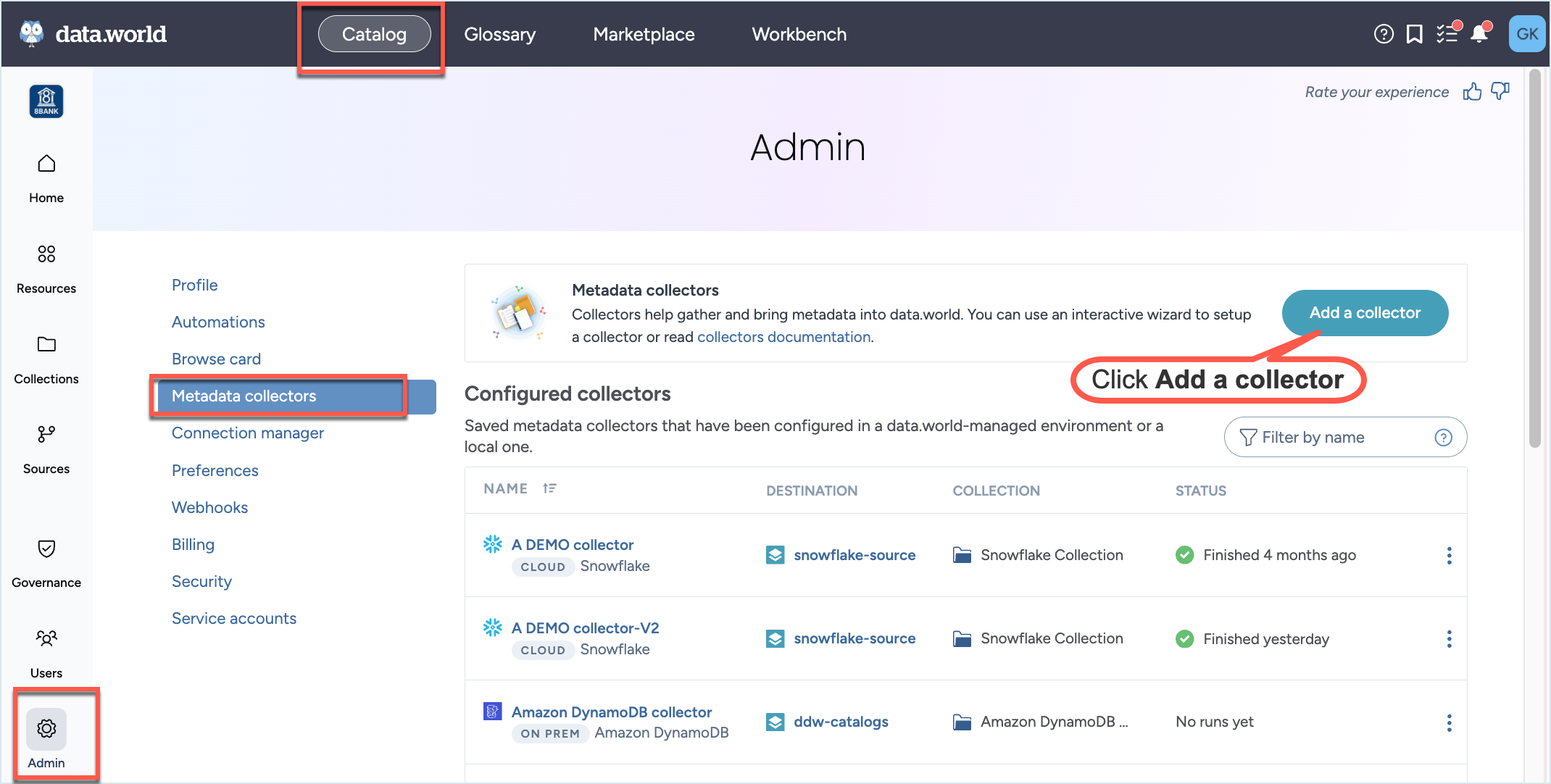
On the Choose metadata collector screen, select the correct metadata source. Click Next.
On the Choose where the collector will run screen, in the Cloud section, select data.world. Click Next.
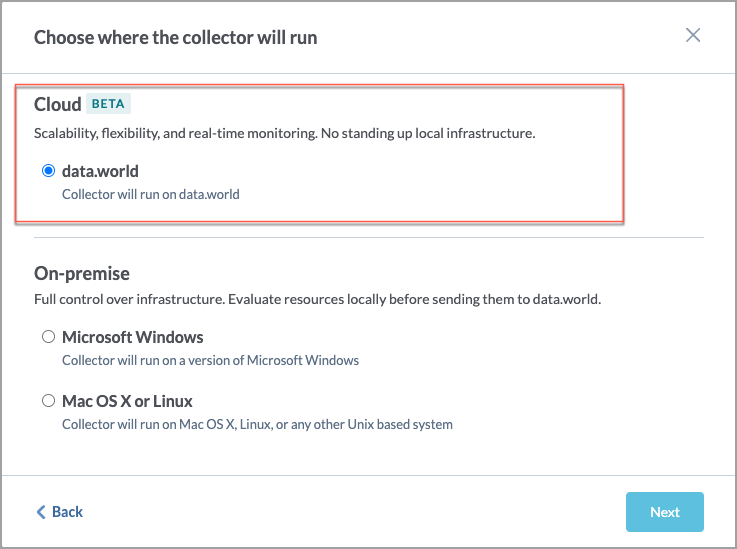
On the Configure a cloud dbt cloud Collector screen, set the following:
On the next screen, set the following properties and click Next.
Table 2.Field name
Description
Required?
dbt Cloud host
Specify the host for your organization's account on dbt cloud. If left unspecified, the default host will be assumed as cloud.getdbt.com.
No
dbt cloud account ID
The dbt cloud account that owns the project from which to harvest dbt metadata artifacts.
Yes
dbt cloud API key
A dbt cloud-issued API key with permissions to access the specified account
Yes
dbt cloud project
The name or numeric identifier of the project from which to harvest dbt metadata artifacts.
Yes
dbt cloud run
The numeric identifier of the run that produced the artifacts to be harvested; if not specified, the most recent successful run that produced artifacts within the project will be harvested.
No
dbt Cloud environment
Specify the dbt Cloud environment (ID or name) used to filter the job runs from which to harvest dbt metadata artifacts.
No
dbt Cloud job
Specify the dbt Cloud job (ID or name) used to filter the job runs from which to harvest dbt metadata artifacts.
No
On the next screen, set the following advanced options and click Next.
Important: You must set the Target database to Snowflake overrides if you want to harvest Snowflake lineage relationships between columns specified through views.
You can authenticate to Snowflake either using the username and password or private key file and password.
By default, the collector obtains the connection information to Snowflake from the identified dbt Cloud run. This connection information includes the Snowflake account, role, and warehouse used to authenticate to Snowflake. You have the option to override the connection information for a given run using the Snowflake account, Snowflake role, and Snowflake warehouse override fields.
Table 3.Field name
Description
Required?
Target database
The dbt cloud collector will obtain database connection information from the connection configured on the Project in dbt cloud. Only use these options to override the values if necessary.
Yes
No Target database overrides
Allows the collector to skip connecting to a data warehouse and only harvest dbt assets. This means no lineage will be available for any views.
Snowflake overrides
Select this option if you want to harvest Snowflake lineage relationships between columns specified through views.
Authentication: Select from one of the following authentication options.
Yes
(if Snowflake overrides is selected)
Option 1: No Snowflake authentication overrides
Option 2: Snowflake username and password overrides
Username
The user credential to use in connecting to the target database.
Password
The password credential to use in connecting to the target database.
Option 3: Snowflake private key file overrides
Database username
Specify the username to use in connecting to the target database.
Snowflake key file path
The private key file to use for authentication with Snowflake (for example rsa_key.p8). Use this option to override the dbt profile.
Snowflake key file password
The password for the private key file to use for authentication with Snowflake, if the key is encrypted and a password was set Use this option to override the dbt profile or cloud configuration.
Other optional resources
Snowflake application
The application connection parameter to use in connecting to the target Snowflake database. Use this option to override the dbt profile or cloud configuration.
Use datadotworld unless otherwise directed.
No
Snowflake account
The Snowflake account/tenant.
No
Snowflake role
The role to use in connecting to the target Snowflake database. Use this option to override the dbt profile or cloud configuration. This is case-insensitive.
No
Snowflake warehouse
The warehouse to use in connecting to the target Snowflake database. Use this option to override the dbt profile or cloud configuration. This is case-insensitive.
No
On the next screen, set the following advanced options and click Next.
Table 4.Field name
Description
Required?
Max retries
Specify the number of times to retry an API call which has failed. The default value is 5.
No
Retry delay
Specify the amount of time in seconds to wait between retries of an API call which has failed. The default is to try with a delay of 2 seconds between each call.
No
API HTTP header
Specify name-value pairs that the collector will include as HTTP headers in any calls to the HTTP API used by the collector to harvest metadata. Use the option multiple times for multiple headers.
Note: Use this option only after consulting the data.world Support team.
No
JDBC driver property
JDBC driver properties to pass through to driver connection, as name=value pair. Use the parameter multiple times for multiple properties.
No
If you are using the NTLM authentication, make sure to set two JDBC properties as:
integratedSecurity=true
authenticationScheme=NTLM
Yes
(if using NTLM authentication)
On the next screen, provide the Collector configuration name and an optional Configuration description, and set the run schedule. You can also set the schedule at a later point.
Click Save and View to go the collector details page.
Testing collector configuration
Test your cloud collector configurations before saving or running them to make sure your connection details are valid and the collector can access the source system.
Use this feature after you have finished entering all configuration fields — such as the server address, authentication credentials, databases, and schemas — to quickly confirm:
The system can connect to the database.
Credentials are valid.
Required schemas are accessible.
To test a collector configuration:
Before saving, use Test configuration to validate your connection and confirm that the collector can access the database and schemas you have specified.
On the Metadata collectors page, click Add a collector.
While configuring the collector, proceed through the setup steps. On the final screen, where you enter the collector configuration name, click Test [Collector Name] configuration.
To test an existing collector, open the configuration by clicking Edit configuration.
Click Next through the setup screens until you reach the final screen, then click Test [Collector Name] configuration.
When you click the Test button, the system attempts to:
Connect to the database using the credentials you provided.
Authenticate using the specified role.
Check schema access, if specific schemas were listed.
Based on the outcome, the collector shows whether the configuration is valid, partially valid — for example, the connection works but a schema is inaccessible — or invalid — for example, due to bad credentials.
If the test fails, an error message appears to help you troubleshoot the issue. For example, Incorrect username or password was specified.

Scheduling collector runs
Important things to note:
Different collectors can be scheduled to run at the same time, but one collector can only run once a day.
It is recommended that you schedule the runs in off-peak hours.
The collector runs in the timezone in which the scheduler is located. For example, if the scheduler sets the collector runs from PST timezone, the collectors will follow the PST timezone.
Runs may start up to one hour after the scheduled time.
Cloud collectors are designed to automatically run against the latest version of the collector supported by the UI.
To schedule collector runs:
On the Configured collectors page, locate the collector you want to run on a schedule.
Click the Edit configurations button.
Go to the screen where you can set the schedule for the collector and set the following:
Enable the Scheduled runs option.
From the Frequency dropdown, select from Daily, Weekly, or Monthly.
For Weekly and Monthly options, select the day when the collector should run.
Select the time for running the collector.
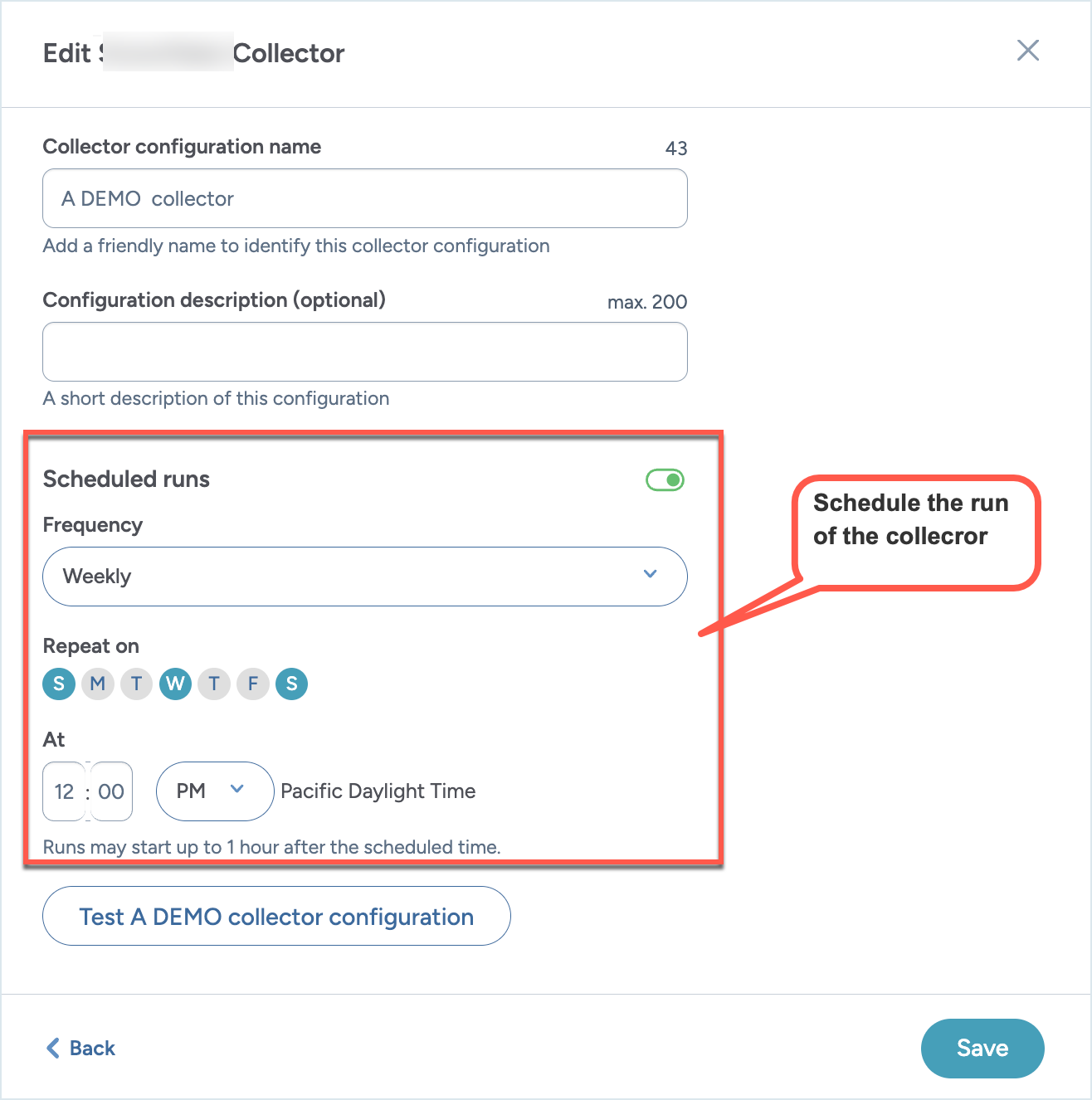
Click Save and view. The schedule and next run date and time are displayed on the collector details page.
To get notifications about the collector runs, simply setup web hooks at the Organization level from the Catalog experience> Admin page. The Webhooks will automatically start capturing the Status events (Pending, Provisioning, Running, Completed, Error, Cancelled) for the collector runs.
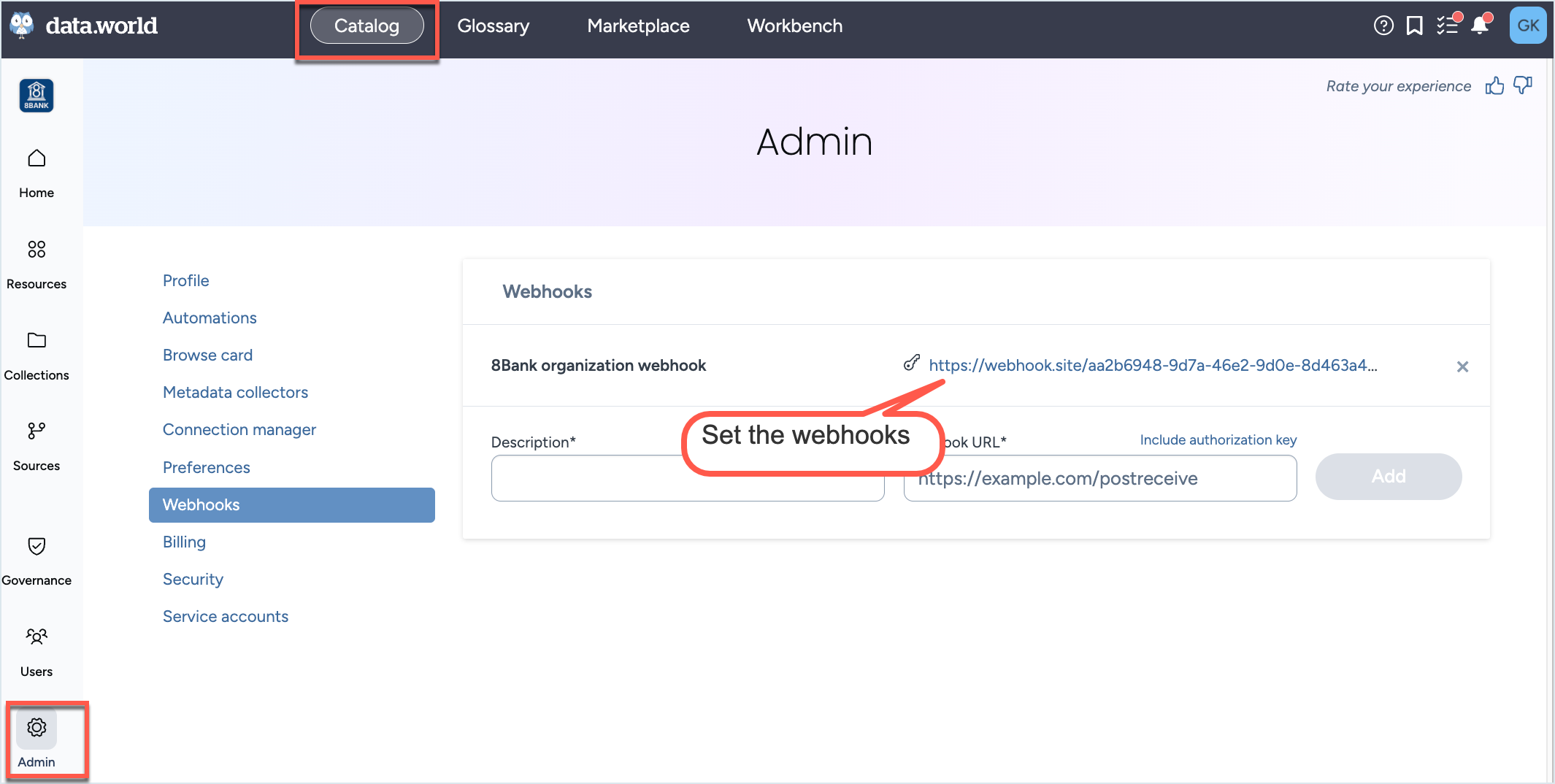
Sample data captured by the webhook.

Running collectors manually
After setting up the collector configuration, it's recommended to manually execute it once to confirm everything is set up correctly. Even for collectors scheduled to run automatically, you can initiate them manually at any time. Cloud collectors are designed to automatically run against the latest version of the collector supported by the UI.
To run the collectors manually:
On the Configured collectors page, locate the collector you want to run.
On the collector configuration details page, click the Run now button. Alternatively, on the Configured collectors page, click the Three dot menu and click Run/Sync now button.
On both pages, the Status field shows the status as Running with information about time elapsed since the run was started.
The collector starts running in the background and you can navigate away from the page at any time. If a collector run errors out, the Status section and the Status field update to an Error state.
After the collector has completed the required pre-configuration steps and starts harvesting the metadata, you get an option to Cancel the harvesting process, if you want. The Status section and the Status field update to Canceled.
After the collector run has completed, the Status section of the collector configuration details page updates to show the successful status. The Last run summary page also updates to show the total number of resource collected and total number of types of resources collected. The Resources collected by type gives granular level information about the number of resources collected for each type of resource.
Browse to the Collection and Dataset specified while running the collector to view the collector output.
To get notifications about the collector runs, simply setup web hooks at the Organization level from the Catalog experience > Admin page. The Webhooks will automatically start capturing the Status events (Pending, Provisioning, Running, Completed, Error, Cancelled) for the collector runs.

Sample data captured by the webhook.

Canceling a collector run
After starting a collector run, you can cancel it if needed.
Important things to note:
Logs generate only after the collector starts up (about 5 minutes). No logs are available if the collector is canceled before this period.
After canceling a run, the collector produces the logs within 5 minutes
To stop a running collector:
Locate the running collector you want to stop. After the collector has completed the required pre-configuration steps and starts harvesting the metadata, you get an option to Cancel it.
On the collector configuration details page, click the Cancel run button. Alternatively, on the Configured collectors page, click the Three dot menu and click Cancel run button.
The collector stops running. On both pages, the Status field shows the status as Canceled with information about time elapsed since the run was canceled.
The collector produces a log file in 5 minutes after stop running. To download a logs, click the View debugging info link. A pop-up window opens.
In the pop-up window, click Export logs to download the log file. The window also includes the Run ID of the collector run that failed. While reporting this issue to data.world support team, include this Run ID to help expedite the troubleshooting process.
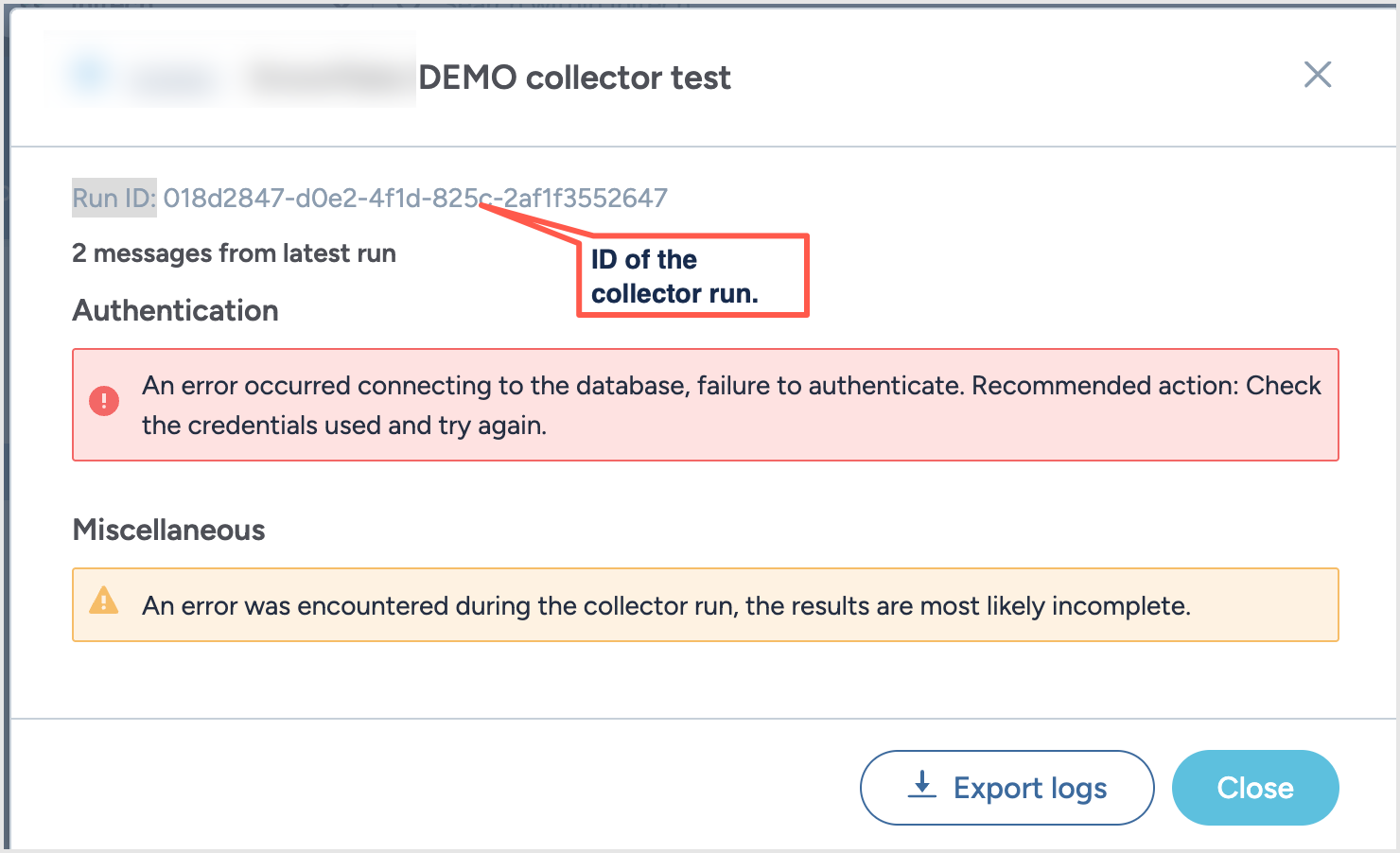
Copying collector configurations
After you have configured a collector for a source system, you can easily create a copy of the configuration to configure another collector for the same source system but for different parameters.
To copy collector configurations:
On the Configured collectors page, locate the collector configuration you want to copy.
From the Three dot menu, click Duplicate configuration.
In the Edit Collector window, provide a new name for the collector configuration. Optionally, set a schedule. Click Save and view.
You are taken to the copied collector configuration page. Click the Edit Configuration button to adjust the details of the configuration.
Deleting configurations
Important things to note:
Deleting the configuration will not affect the resources that were collected from previous runs.
Any scheduled future runs for the collector are suspended.
To delete a configuration:
On the Configured collectors page, locate the collector configuration you want to delete.
From the Three dot menu, click the Delete configuration button.
Confirm the deletion. The configuration is deleted and removed from the Configured collectors page.